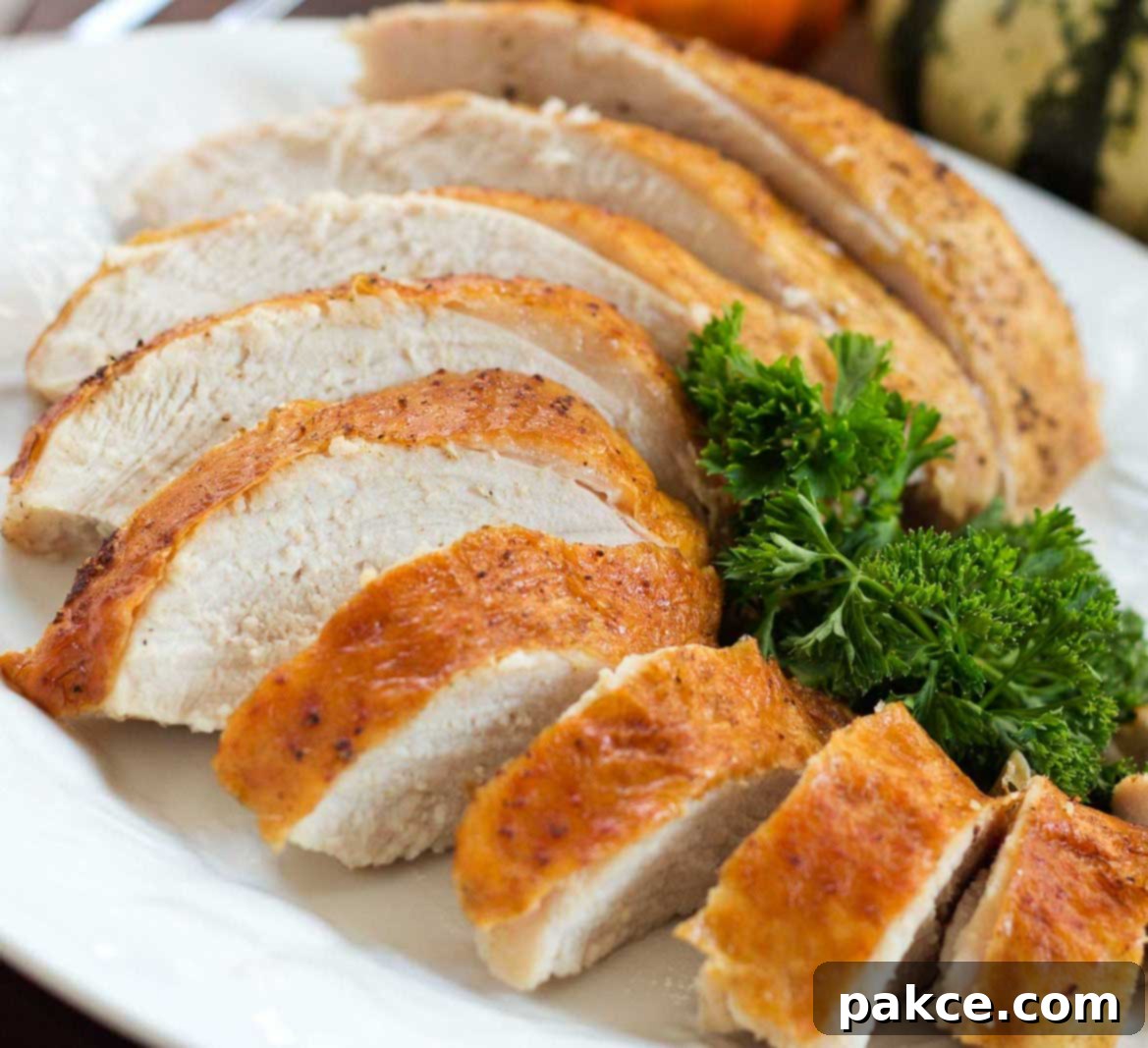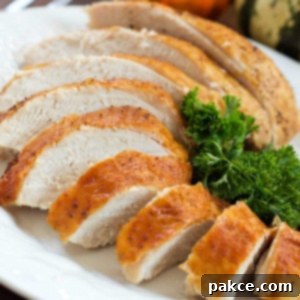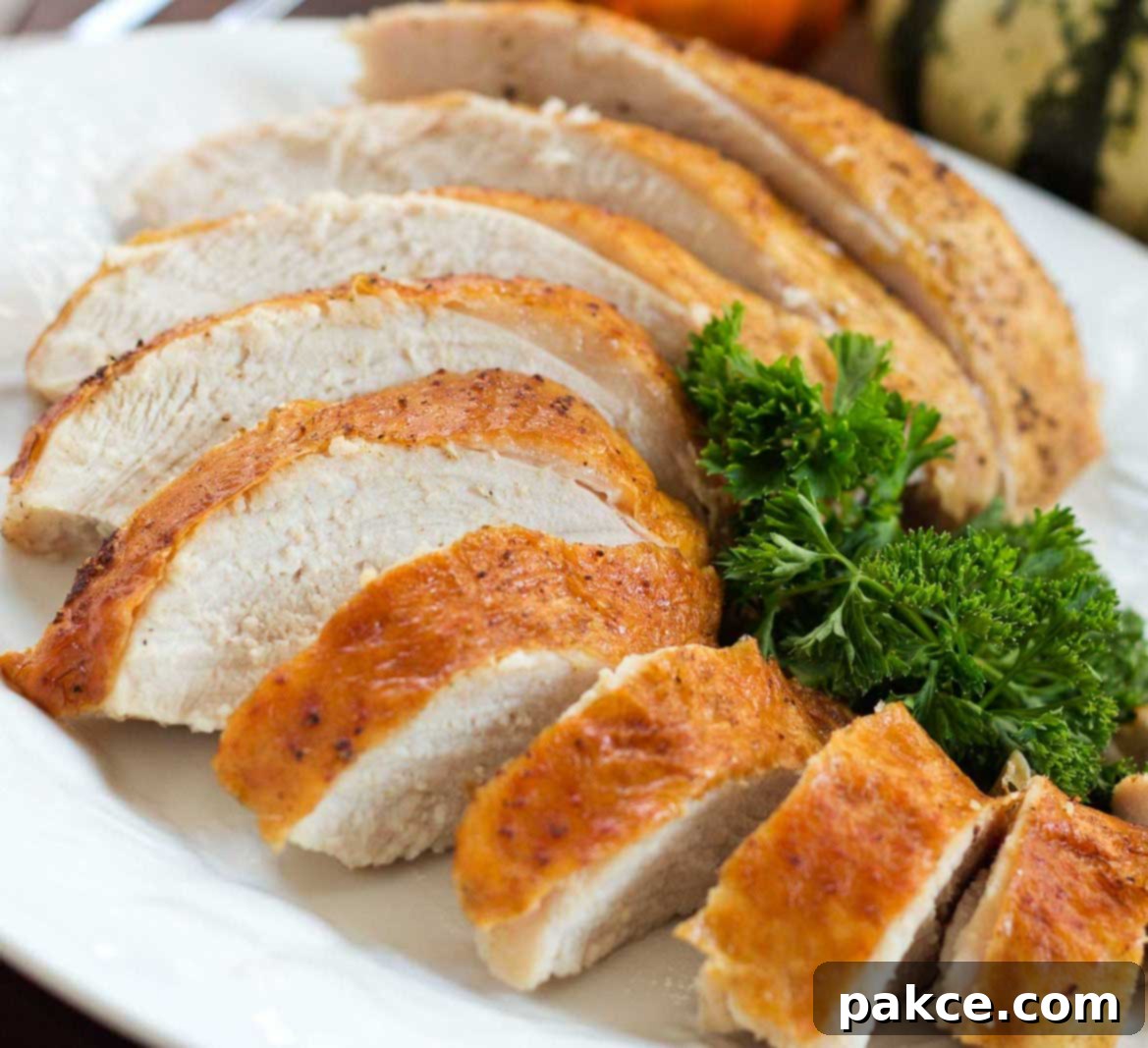Mastering the Perfect Holiday Roast Turkey: An Easy Guide to Tender, Juicy Flavor (with Homemade Gravy!)
There’s something truly special about a beautifully roasted turkey gracing your holiday table. It’s often the centerpiece, a symbol of gathering, gratitude, and delicious indulgence. Yet, for many home cooks, the thought of roasting a whole turkey can feel daunting. Visions of dry meat, complicated steps, and a mountain of dirty dishes might make you reconsider. But what if the secret to the most tender, flavorful turkey was also the easiest?
This comprehensive guide will demystify the art of slow-roasting a turkey, proving that sometimes, the best results come from the simplest methods. We’ll walk you through preparing a magnificent bird seasoned with a delectable turkey rub, ensuring a succulent, moist centerpiece for your holiday meal, complete with a rich, homemade gravy that will earn you rave reviews. Whether it’s Thanksgiving, Christmas, or any special occasion, this foolproof recipe is designed to help you achieve turkey perfection with minimal stress.

Why Slow Roasting is the Secret to Succulent Turkey
Many traditional turkey recipes call for high heat initially, then reducing it, or constantly basting. While these methods can yield good results, they often lead to uneven cooking and can dry out parts of the bird. Slow roasting, on the other hand, is a game-changer. By cooking the turkey at a lower temperature for a longer period, you allow the heat to penetrate evenly, gently rendering the fat and breaking down the connective tissues. This results in incredibly tender meat that’s moist from edge to center, with beautifully golden, crispy skin. The slower cooking process also minimizes the chances of overcooking, giving you a more forgiving window to achieve perfection.
The addition of a flavorful turkey rub isn’t just about surface taste; it locks in moisture and creates a fragrant crust that enhances every bite. Combined with the pan drippings, this rub becomes the foundation for an unforgettable homemade gravy that ties the entire meal together. Say goodbye to dry, bland turkey and hello to a culinary triumph!
Choosing and Preparing Your Turkey
Selecting the right turkey is the first step towards a successful holiday meal. Consider the number of guests you’ll be serving. A general rule of thumb is 1.5 pounds of turkey per person, allowing for generous servings and some leftovers. If your family, like many, prefers white meat, consider roasting two smaller turkey breasts rather than a whole large bird. This not only caters to preferences but can also simplify the cooking process.
Whether you choose a fresh or frozen turkey, proper preparation is crucial. If frozen, ensure you allow ample time for thawing in the refrigerator—typically 24 hours for every 4-5 pounds. Never thaw at room temperature. Once thawed, remove any giblets or neck from the turkey cavity. Rinse the turkey thoroughly inside and out with cold water, then pat it completely dry with paper towels. A dry surface is key for achieving that coveted crispy skin. This initial prep sets the stage for the seasonings to adhere beautifully and helps the skin crisp up evenly during roasting.
Recipe

Easy Roast Turkey and Gravy
Add to Shopping ListGo to Shopping List
Ingredients
- 12 pounds turkey, fresh or thawed, whole or turkey breasts (see notes for smaller portions)
- ⅓ cup vegetable oil (or olive oil, melted butter for richness)
- 4 tablespoon turkey rub (store-bought or homemade, see notes for ideas)
- 1 extra large cooking bag, such as Reynold’s cooking bags for turkeys (optional, for oven without roaster)
Gravy
- ½ cup warm water (for flour slurry)
- 2 tablespoons all-purpose flour (for thickening, or gravy packet if available)
- 1 can chicken broth (optional, for stretching gravy)
Instructions
Turkey:
-
These instructions are specifically tailored for cooking the turkey in an oven using a covered roaster (like a Dutch oven or a traditional roasting pan with a lid), or in an electric roaster. These methods help trap moisture, leading to a juicier bird. For alternative cooking instructions, such as using a cooking bag or a slow cooker, please refer to the comprehensive notes section below.
-
Carefully remove the giblets (e.g., heart, liver, gizzard) and the neck from the turkey’s cavity. These are often tucked inside a small bag. You can reserve them for making stock or discard them. Rinse the turkey thoroughly, both inside and out, with cold water. Pat the turkey completely dry with paper towels; a dry surface is crucial for a crispy skin.
-
Generously rub the entire skin of the turkey with the vegetable oil. This layer of oil will help the turkey rub adhere, promote browning, and contribute to that coveted crispy skin. You can also use melted butter for an even richer flavor.
-
Evenly sprinkle the turkey rub all over the turkey’s exterior, including under the wings and legs. If using a large whole turkey, you can also gently loosen the skin over the breast and rub some seasoning directly onto the meat for deeper flavor. Massage the rub into the skin to ensure full coverage and maximum flavor infusion.
-
Place the prepared turkey in your roasting pan or electric roaster. Always follow the time and temperature recommendations provided with your specific turkey, as sizes can vary. As a general guideline, for an unstuffed turkey, plan for approximately 15 minutes of cooking time per pound at a consistent temperature of 325ºF (160ºC). If you choose to stuff your turkey (ensure it’s no larger than 24 lbs. for food safety reasons), the cooking time will be slightly longer, around 18 minutes per pound at the same temperature. The most accurate way to determine doneness is by using an internal meat thermometer. The turkey is fully cooked when it reaches an internal temperature of 165ºF (74ºC) in the deepest part of the thigh (without touching bone), the wing, and the thickest part of the breast. While some older guidelines suggested 180ºF, 165ºF is the scientifically recognized safe temperature for poultry.
-
Once your turkey has reached the safe internal temperature, carefully remove it from the roasting pan. Transfer it to a large cutting board and tent it loosely with aluminum foil. Allow the turkey to rest for at least 20 to 30 minutes before you begin carving. This crucial resting period allows the juices to redistribute throughout the meat, resulting in an incredibly tender and moist turkey. Skipping this step often leads to dry meat.
Gravy:
-
After removing the turkey, carefully pour all the savory drippings from the roasting pan (or cooking bag) into a saucepan. To ensure a smooth gravy, pass the drippings through a fine-mesh strainer to remove any solids, bits of rub, or turkey skin.
-
If your turkey came with a convenient gravy packet (often found with frozen turkeys), now is the time to use it! Follow the specific instructions on the packet, combining it with the strained turkey drippings. This is a quick and easy way to make a flavorful gravy.
-
If you don’t have a gravy packet or prefer a homemade approach, prepare a simple flour slurry: in a glass jar with a tight-fitting lid, combine ½ cup of warm water and 2 tablespoons of all-purpose flour. Secure the lid tightly and shake vigorously until the flour is completely dissolved and no lumps remain. This ensures a smooth, lump-free gravy. Add this slurry directly into your strained turkey drippings in the saucepan.
-
Place the saucepan with the drippings and thickening agent over medium heat. Stir frequently, scraping the bottom of the pan to incorporate all the flavorful bits. Continue heating and stirring until the gravy thickens to your desired consistency – it should coat the back of a spoon. If you find yourself needing more gravy to feed a larger crowd, or if the flavor is too intense, you can gradually add all or part of a can of chicken broth to stretch it out and adjust the seasoning. Taste and adjust salt and pepper as needed.
-
For the ultimate silky-smooth gravy, pour it through a fine-mesh strainer one last time directly into your gravy boat or serving vessel. This step removes any last potential lumps or small solids, ensuring a professional, delectable gravy that will be the perfect accompaniment to your tender roast turkey. Serve hot and enjoy!
Notes
Serving Smaller Crowds: For many families, especially smaller gatherings, a large 12-pound turkey can lead to an overwhelming amount of leftovers. If a whole roasted turkey isn’t practical or if your family primarily enjoys white meat, consider roasting 2 turkey breasts instead of one whole bird. The cooking principles remain largely the same, but the cooking time will be significantly reduced, and you’ll still achieve incredibly moist and flavorful meat. This also frees up valuable oven space for other holiday dishes.
Crockpot Turkey Breasts for Ultimate Tenderness: If you’re opting for turkey breasts and presentation isn’t your top priority, a crockpot (slow cooker) can be your best friend. This method yields the most tender and unbelievably juicy turkey meat imaginable. It’s also fantastic for freeing up your oven for side dishes. Approximate cooking times for turkey breasts in a crockpot are similar to oven times (around 3-4 hours on high or 6-8 hours on low, depending on size). However, be aware that a crockpot turkey is so tender it will likely fall off the bone, making it challenging to remove in one perfect piece. It’s ideal for shredded turkey or if you plan to carve it directly into serving portions.
Oven Roasting Without a Covered Roaster: If you don’t possess a roasting pan with a lid, don’t fret! A reliable cooking bag can achieve similar results, keeping your turkey exceptionally moist and tender. Simply follow the instructions provided with your cooking bag (such as Reynold’s Turkey Size cooking bags). These bags trap steam, creating a self-basting environment that prevents drying out. Ensure the bag is properly vented to allow steam to escape and help with browning.
Alternative Cooking Methods (Grilling & Smoking): For those who love the smoky flavors of outdoor cooking, grilling or smoking a turkey is an excellent option. These methods can impart unique tastes and textures. For detailed instructions and safety tips on grilling and smoking your holiday turkey, refer to resources like Clemson HGIC’s guide on cooking the holiday turkey.
Safe Handling Practices: Food safety is paramount when dealing with poultry. Always ensure your turkey is properly thawed, handled with clean hands and sanitized surfaces, and cooked to the correct internal temperature of 165ºF (74ºC). Avoid cross-contamination by keeping raw turkey separate from other foods. For comprehensive guidelines on the safe handling of poultry, consult resources such as Clemson HGIC’s factsheet on safe handling of poultry.
Questions and USDA Hotline: If you ever have any specific questions or concerns about the safe handling and preparation of your turkey, don’t hesitate to reach out to experts. You may contact the USDA Meat and Poultry Hotline at (888) 674-6854, available Monday through Friday from 10 am to 4 pm EST. They are an invaluable resource for ensuring your holiday meal is not only delicious but also safe.
Nutrition per serving
Share
Pin
Beyond the Recipe: Tips for Holiday Turkey Success
Perfect Carving Techniques
Once your beautifully roasted turkey has rested, it’s time to carve. A sharp carving knife and a sturdy carving fork are essential. Start by removing the legs and thighs, separating them at the joint. Then, slice the breast meat parallel to the breastbone. For white meat lovers, removing the entire breast in one piece and then slicing across the grain can yield elegant, uniformly sized slices. Remember, serving the turkey warm is key, so have your serving platter ready!
Storing Leftovers Safely
Leftovers are one of the best parts of a holiday meal! To ensure they remain safe and delicious, store cooked turkey promptly. Within two hours of cooking, carve any remaining meat off the bone and store it in shallow, airtight containers in the refrigerator. Consume within 3-4 days. For longer storage, freeze turkey in airtight containers or freezer bags for up to 2-3 months. This rapid cooling and proper storage prevent bacterial growth and maintain freshness.
Creative Leftover Ideas
Don’t let any of that delicious turkey go to waste! Leftover roast turkey is incredibly versatile. Here are a few ideas:
- Turkey Sandwiches: Classic and comforting, layer sliced turkey with cranberry sauce, stuffing, and gravy on bread.
- Turkey Soup: Use the carcass to make a rich turkey stock, then add shredded turkey, vegetables, and noodles for a hearty soup.
- Turkey Pot Pie: Combine shredded turkey with leftover vegetables and gravy under a flaky pie crust.
- Turkey Tetrazzini: A creamy pasta bake with turkey, mushrooms, and cheese.
- Turkey Salad: Mix diced turkey with celery, mayo, and herbs for a light lunch.
These ideas ensure that your delicious roast turkey continues to provide enjoyment long after the main meal.
Conclusion
Roasting a magnificent turkey for your holiday celebration doesn’t have to be a source of stress. By following this easy, slow-roasting method and incorporating a flavorful turkey rub, you’re well on your way to creating a tender, juicy, and incredibly delicious centerpiece that will impress your family and friends. With the added bonus of a rich, homemade gravy made from the pan drippings, your holiday feast will be unforgettable.
Remember to prioritize food safety, use a meat thermometer for accurate doneness, and allow your turkey to rest before carving. These simple steps, combined with the techniques outlined in this guide, will empower you to master the art of the perfect holiday roast turkey. So, gather your ingredients, preheat your oven, and prepare to enjoy a truly spectacular meal. Happy roasting!
